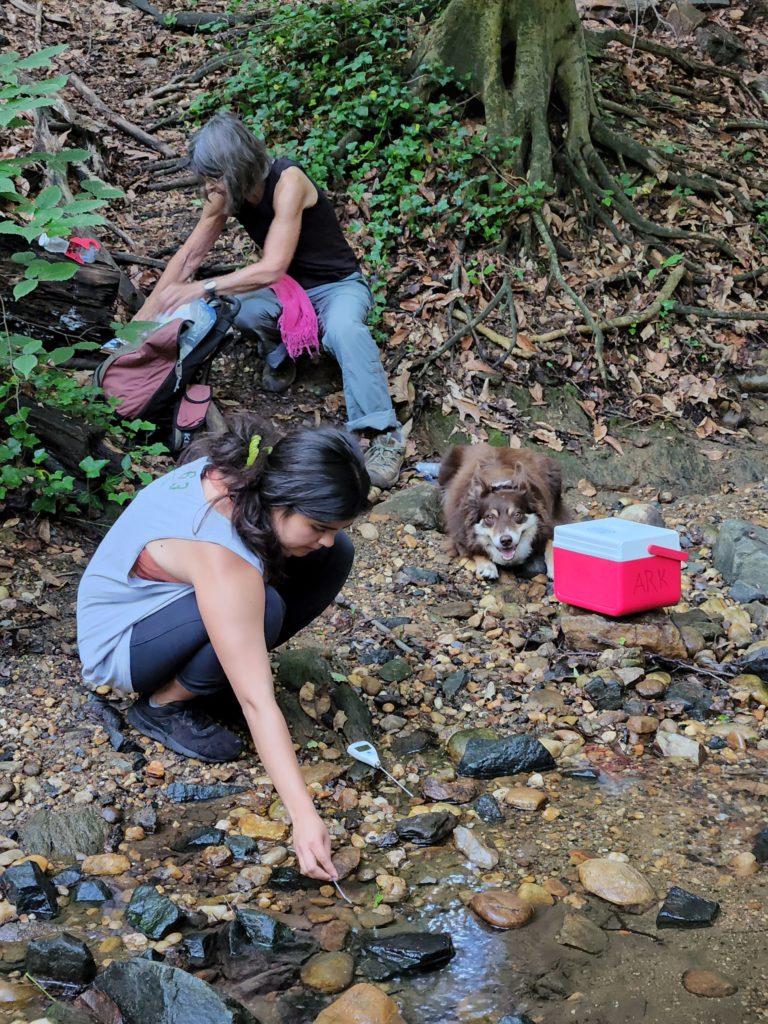
By Maya Sterett, Alliance for the Chesapeake Bay, DC Projects Associate and Petra Baldwin, Anacostia Riverkeeper, Project Coordinator
The summer of 2022 marked the fourth year of the DC Citizen Science Water Quality Monitoring program, funded by our partners at the Department of Energy and Environment (DOEE) and led by Alliance for the Chesapeake Bay, Anacostia Riverkeeper, Rock Creek Conservancy, and Nature Forward. From May to September, during the peak recreation season, volunteers braved DC traffic each week to collect valuable water quality data about their watershed. Our volunteers helped us provide up-to-date, weekly water quality data to visitors and residents.
Across 24 sites along the Potomac River, Anacostia River, and Rock Creek, volunteers dunked sample bottles into the rivers and creeks to collect bacteria and turbidity samples for lab analysis, read the air and water temperature with field thermometers, and dipped litmus paper into the water to record pH. Volunteers also recorded valuable recreational use data, noting when rowers, fishermen, or hikers went past the site. All sampling data was then processed at the Anacostia Riverkeeper lab and shared by project partners on Fridays, so the public could make informed decisions about how and when they recreate on their local waterways. All data was published on social media, Water Reporter, and the Chesapeake Data Explorer.
2022 DC Water Quality Data Snapshot
Assessing overall trends in District water quality, the Anacostia River and Potomac River had multiple sites that met the water quality standards in DC for E. coli most of the summer. The District has water quality standards that are upheld to meet Clean Water Act requirements and to restore and protect the District waters. The most recent iteration of DC’s water quality standards states that the healthy standards for these waters are: pH between 6.5-8, water temperature <32.3°C and turbidity <20NTU above ambient. For bacteria (E.coli), we most commonly use the geometric mean standard: at or below 126 MPN/100 mL, or Most Probable Number of microorganisms (in this case E.coli) per 100mL of sample water. The geometric mean gives a broader picture of water quality beyond a single sample by calculating the average of 5 samples over 30 days.
On the Anacostia River, Buzzard Point and the Wharf sites had the healthiest bacteria results, passing 93% of the time. On the Potomac River, best results come from the Tidal Basin (94%), Columbia Island (67%), and Thompson Boat House (53% passing rate). The highest passing rate for Rock Creek sites was Pinehurst Branch at 7% of the summer.
On average, sites overwhelmingly passed DC recreational contact standards for turbidity (<20NTU), pH (between 6.5 and 8), and water temperature <32.5°C (<90.5°F) with fluctuations occurring most often after periods of high precipitation.
All three District waterways see weekday recreational use throughout the summer, and it’s great to see residents and visitors enjoying the local waterways! A big part of the project’s goal is to provide timely water quality data to potential recreators in Potomac River, Anacostia River and Rock Creek. It is important to get a sense of how much recreation occurs on and around these waters. Our volunteers recorded many sightings of rowing, powerboating, kayaking, fishing, and walking, with the Potomac River seeing the majority of the observed recreation use. Considering last year’s monitoring results, caution should be taken for high water contact sports during periods of potentially high-bacteria-count events like rain, and for sites that do not routinely pass the water quality standards.
The full 2022 report can be found on Anacostia Riverkeeper’s website.
2023 Monitoring Season
Currently, we are gearing up for the 2023 monitoring season! If you live in the DC metro area and are interested in expanding your stewardship, we welcome you to come monitor with us! All equipment and training will be provided.
Our next trainings will be:
● April 1st – In-Person Training at Thompson Boat Center at 1pm – 4pm
● April 5th – Virtual Training at 10am – 12pm
● April 12th – Virtual Training at 10am – 12pm
For more information about the program and to register for a training session, please see Alliance for the Chesapeake Bay’s webpage or email monitor@anacostiariverkeeper.org for more information.
A version of this article was originally published on the Alliance for the Chesapeake Bay’s website.

